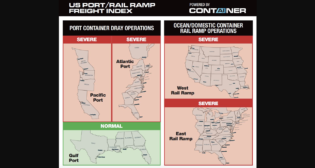
Adore or abhor income protection? Thank Jim Hodgson
Written by Frank N. Wilner, Capitol Hill Contributing EditorIncome protection is the continued payment of wages and benefits to railroaders displaced because of mergers, consolidations, line sales and abandonments—and to Amtrak workers displaced due to service cuts.
Hodgson was a Democrat in the Republican Nixon Administration—a former labor negotiator with Lockheed Aircraft—and as labor secretary he often poked organized labor in its eye by opposing increases in the minimum wage, supporting wage freezes, and urging a law to prohibit strikes. Yet he did an about-face on income protection for Amtrak workers with a most generous binding arbitration decision that had wide and long-term repercussions for railroads and their employees, extending to today.
Amtrak and the Nixon Administration were strange bedfellows from the get-go. Nixon was expected not to sign into law the legislation creating Amtrak, yet he did so in seclusion at his western White House in San Clemente, Calif., with no press release served up by the White House. Readers of Nixon’s biography know why. The son of a streetcar conductor, Nixon recalls growing up in Yorba Linda, Calif., dreaming of becoming a locomotive engineer.
So it was that Nixon’s usually labor-baiting Secretary of Labor Hodgson was handed an arbiter’s gavel at a crucial stage in Amtrak’s first foray into collective bargaining.
Amtrak’s enabling legislation, the Rail Passenger Service Act of 1970, provided for “fair and equitable” protective arrangements for Amtrak employees dismissed or displaced by any discontinuance of intercity rail passenger service—a provision nimbly slipped into the law by House Commerce Committee Chairman Harley O. Staggers (D-W.Va) at the urging of the United Transportation Union’s chief lobbyist and subsequent president, Al Chesser.
The law’s provision did not specify the number of years that income protection should be paid, but rather provided for collective bargaining, with the Secretary of Labor to make the binding determination if Amtrak and its unions could not agree.
Collective bargaining did not produce a settlement, resulting in Hodgson promulgating labor protective conditions designated as Appendix C-1 and C-2 to Amtrak labor contracts.
Appendix C-1 protected Amtrak workers adversely affected after transferring employment from privately owned freight railroads to Amtrak. Appendix C-2 protected Amtrak employees from subsequent passenger train service cuts, with the trigger being any reduction below three trains per week.
In both cases, displaced Amtrak workers were guaranteed by Hodgson’s arbitration decision the continuation of wages and benefits for up to six years if displaced by certain service cuts—an unprecedented time period.
Indeed, during ensuing congressional attempts to reduce Amtrak funding, the specter of massive income protection costs (some asserted more than $6 billion) was raised as certain to cost the federal treasury more than the savings expected from reduced or eliminated Amtrak service.
It was not until 1997 that Amtrak took a hard line in wage negotiations, demanding a reduction in income protection payments so as to afford Amtrak greater managerial flexibility in reducing costs by reducing service in lightly used corridors.
Help came from Congress through the Amtrak Reform and Accountability Act of 1997, which repealed the statutory three-trains-per-week minimum trigger for income protection, and ordered collective bargaining over the time period for any remaining income protection for Amtrak workers.
Of course, the sides could not agree, with subsequent binding arbitration mostly going in favor of labor. Retained by the 1997 arbitration decision (a different arbitrator than Hodgson) was the three-trains per week trigger for income protection, with the labor contract now setting the trigger. As for the time period, the arbitration decision reduced the maximum income protection period by one year to five for Amtrak workers.
How about freight railroads?
Income protection in the railroad industry dates to a collectively bargained Washington Job Protection Agreement of 1936, which was codified by Congress in the Transportation Act of 1940. This Act instructed the Interstate Commerce Commission (now the Surface Transportation Board) to ensure that when railroads are leased, merged, or consolidated, no employee of the involved carriers is to be placed in a worse position—with regard to wages and benefits—for four years from the date of the transaction.
In 1950, the Supreme Court ruled that the four-year statutory period for income protection is a minimum, and can be increased by a regulatory agency.
And so it was by the ICC—from four years to six years for freight railroad employees. Credit that, in part, to the Railroad Revitalization and Regulatory Reform (4-R) Act of 1976, which provided that “no less generous” income protection is to be provided displaced railroad workers than has been previously applied. The rest of the credit goes to Hodgson, as the word “previous” in the statute was deemed by the ICC to be Hodgson‘s six-year income protection decree for Amtrak employees. The 4-R Act also extended income protection to line abandonments.
When Congress passed the Interstate Commerce Commission Termination Act in 1995 (which created the STB), a so-called safe harbor (elimination of income protection payments, or a shortening of its time period to just one year, in some cases) was created for newly created short line railroads and for certain transactions among short lines and regional railroads. Unaffected were Class I railroad mergers, consolidations, leases, and track abandonments, which still afford adversely affected workers up to six years of income protection.
If you are wondering about so-called lifetime income protection, such arrangements were achieved at the bargaining table—and there were many intended to gain rail labor’s support for a merger or consolidation. In one instance—creation of federally owned Conrail out of the ashes of bankrupt Penn Central and other Northeast railroads—it was Congress that mandated lifetime income protection, extending that provision from a collectively bargained Penn Central agreement. But when the costs spiraled, Congress substituted lower lump sum payments.
Whether you adore or abhor income protection, much of the thanks is due President Nixon’s Labor Secretary Jim Hodgson.



